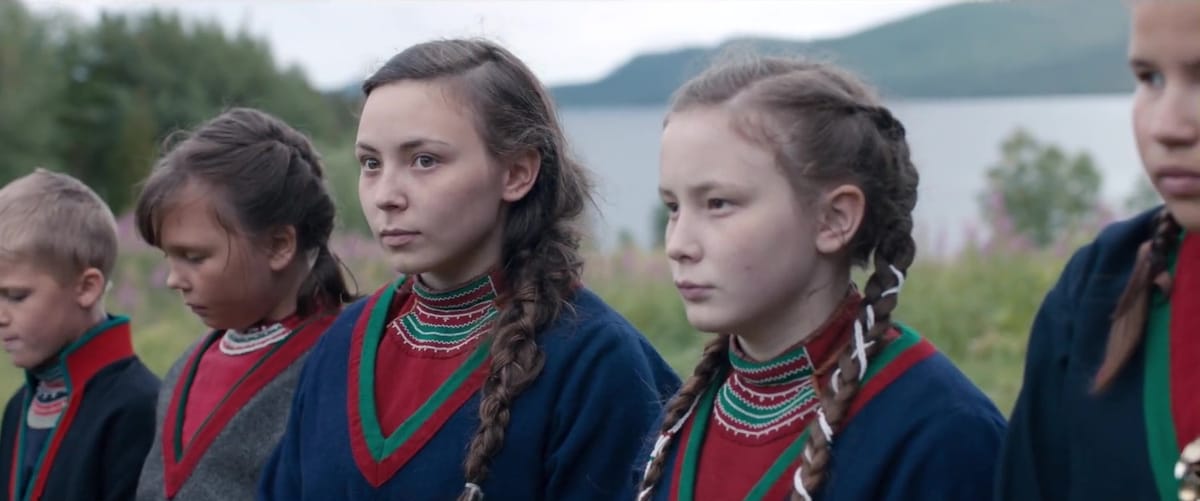What we leave behind to survive.

SAMI BLOOD is one of those films that doesn’t raise its voice yet still hits with the force of a hammer. It’s quiet, restrained, almost minimalistic — but there’s a sharpness beneath every scene, every gesture, every silence. The film isn’t interested in comforting its audience or wrapping history in soft lighting. It’s interested in truth, in identity, in the kind of trauma that shapes a person so deeply that escape becomes both salvation and betrayal.
The story follows Elle-Marja, a young Sámi girl in 1930s Sweden who’s forced into a world designed to dismantle her. The boarding school she attends isn’t a place of education; it’s a cultural pressure chamber. Everything about the institution — the uniforms, the surveillance, the medical inspections, the language bans — exists to push her toward assimilation. The film never sensationalizes any of it. It doesn’t need to. The violence is bureaucratic, polite, cold, scientific. The most horrifying scenes are carried out in daylight by people who think they’re doing “good work.”
What makes Elle-Marja compelling is that she isn’t framed as an emblem of resistance. She’s ambitious, intelligent, frustrated, and increasingly angry at the narrow life the system has assigned her. Her dream isn’t rebellion; it’s escape. And escape, in her world, requires cutting off pieces of herself until there’s almost nothing recognizable left. Her decision to leave her Sámi family behind isn’t heroic or cruel — it’s survival. A brutal, deeply human form of survival.
The film refuses to turn her into a martyr for cultural identity. Instead, it gives us a protagonist who internalizes the racism around her, absorbs it, weaponizes it, and directs it back at her own origins. That complexity is rare. Most films about cultural oppression place resistance on a pedestal. SAMI BLOOD sits with assimilation — not as victory, but as self-erasure that still makes sense within a violently racist environment.
Lene Cecilia Sparrok, who plays Elle-Marja, carries the film with an intensity that never feels performed. Her restraint is devastating. She communicates humiliation, rage, longing, and shame without needing to speak. Her eyes do most of the work — eyes that keep watching doors she can’t open, futures she’s told she can’t have, people she’s told she can’t become.
The film’s visual language reinforces that emotional claustrophobia. The Swedish countryside is filmed with a cold beauty — wide landscapes that somehow feel suffocating. Nature isn’t a romantic refuge; it’s a reminder of how isolated and vulnerable Elle-Marja is. In contrast, the scenes in the town — the places she desperately wants access to — are full of invisible walls. Doors slammed in her face. Mansions she cleans but cannot enter as a guest. Schools where she can study, but only if she lies about who she is.
The film’s cruelty is quiet. A measuring tape. A photograph taken without consent. A scientific “study” presented with a smile. A teacher who praises her intelligence while reminding her of her inferiority. Each moment lands because the film trusts the audience to understand the violence without exaggeration. It’s the kind of story where the smallest humiliation hurts more than any physical blow.
What makes SAMI BLOOD so effective is that it never begs for sympathy. It doesn’t chase catharsis. It doesn’t promise reconciliation. It presents trauma as something that lives in the body — something inherited, something passed down, something never fully healed. The final scenes make that clear: adulthood doesn’t erase childhood. Success doesn’t erase shame. Reinvention doesn’t erase what was sacrificed.
It’s one of the most honest portrayals of cultural rupture ever put on screen. The film’s power comes from its refusal to offer easy answers. There is no perfect version of identity here. No “right way” to survive colonization. No path that doesn’t cost something.
SAMI BLOOD is about the price of escape, the weight of belonging, and the long shadow of enforced assimilation. It’s about a girl who wanted more than she was allowed to have — and the part of herself she had to bury to reach it. It’s harsh. It’s unsettling. And it’s absolutely unforgettable.




